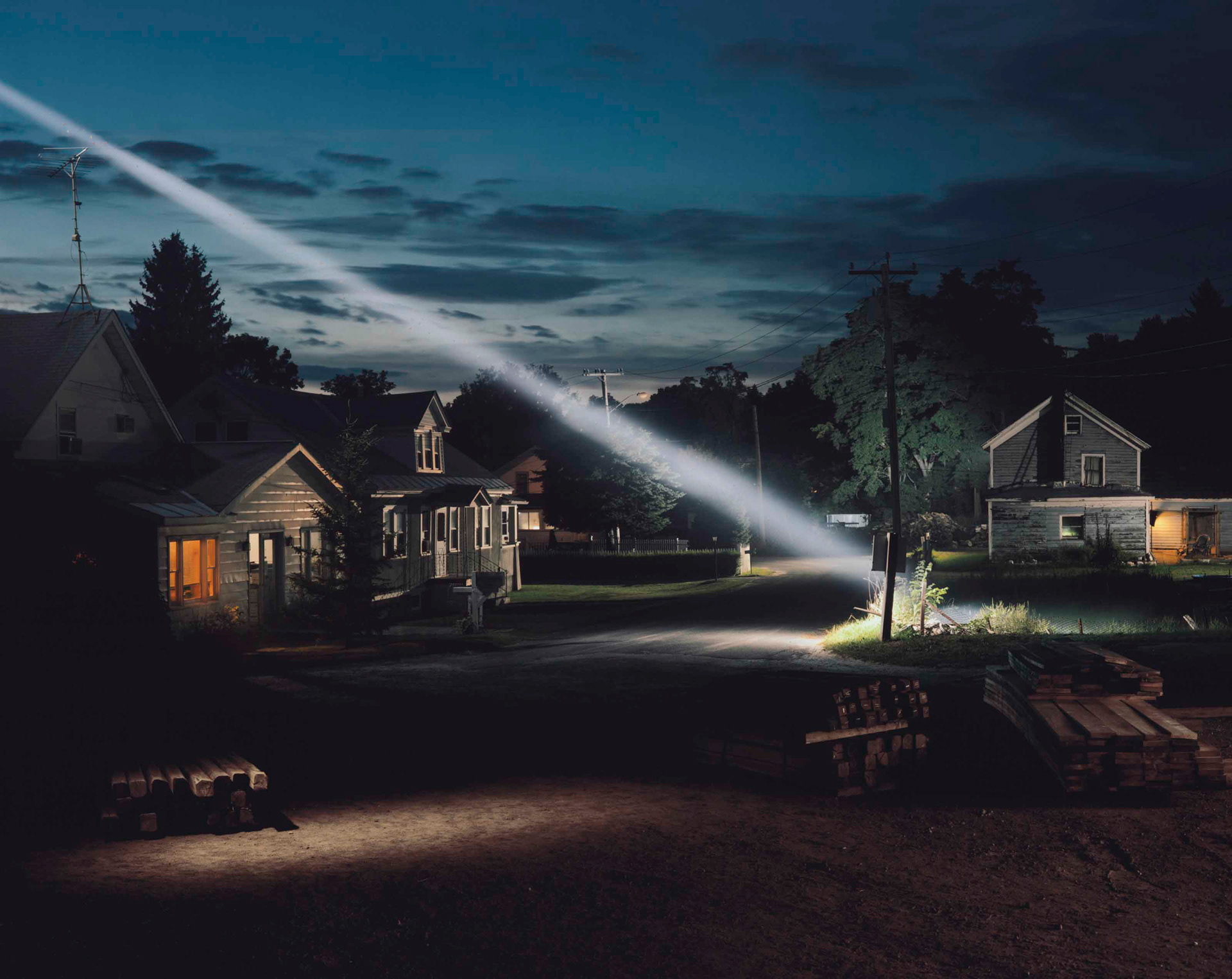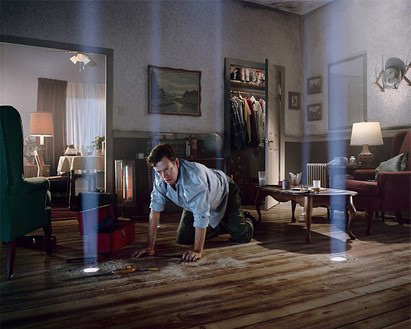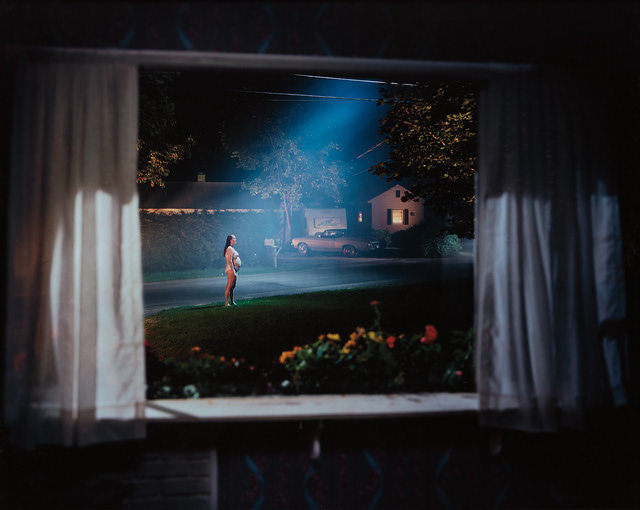You cannot talk about cinematic photography without looking at the works of Gregory Crewdson. He is most definitely the world-leading photographer when it comes to creating cinematic imagery. Opening the viewer into another world and making them question what is going on in the supernatural worlds that he creates using movie-like productions. Crewdson’s work is made on large format cameras and when printed, the images are sometimes 2 meters long. Allowing the viewer to look in on every detail in the photograph which builds the narratives in his images. The uncanny is a theme that runs throughout Crewdon’s photographs. The feeling of something that is familiar yet strange. A feeling of unease that something is about to happen if it has not already. The narratives can be interpreted in more than one way and differed by the viewers’ past experiences. All of Crewdson’s work lies in the middle ground of reality and dreams which I think takes the viewer into a deeper thought of supernatural activities.
Gregory Crewdson is an American photographer. He photographs are tableaux’s of American homes and neighbourhoods. Crewdson was born in the Park Slope neighbourhood of Brooklyn, New York. He attended John Dewey High School, graduating early.
As a teenager, he was part of a punk rock group called The Speedies that hit the New York scene. Their song, "Let Me Take Your Photo" proved to be prophetic to Crewdson's future career. In 2005, Hewlett Packard used the song in advertisements to promote its digital cameras.At Purchase College, State University of New York, he began experimenting with photography, not yet taking it seriously, Crewdson only saw it as a creative outlet and hobby. Gaining school recognition and a growing interest for art, he graduated undergraduate from SUNY Purchase and later attended Yale University receiving his Master of Fine Arts. His senior thesis embodied everyday life through portraiture of Lee, Massachusetts residents, the same location that later inspired his first series Natural Wonder from 1992 to 1997. He has taught at Sarah Lawrence, Cooper Union, Vassar College, and Yale University, where he has been on the faculty since 1993. He is now a professor at the Yale University School of Art. In 2012, he was the subject of the feature documentary film Gregory Crewdson: Brief Encounters. The film series followed the construction and the behind-the-scenes explanation from Crewdson himself of his thought process and vision for his pieces of his collection Beneath the Roses.
Crewdson's photographs usually take place in small-town America, but are dramatic and cinematic. They feature often disturbing, surreal events. His photographs are elaborately staged and lit using crews familiar with motion picture production and lighting large scenes using motion picture film equipment and techniques. He has cited the films Vertigo, The Night of the Hunter, Close Encounters of the Third Kind, Blue Velvet, and Safe as having influenced his style, as well as the painter Edward Hopper and photographer Diane Arbus.
Gregory Crewdson's most recognized and iconic collection is Beneath the Roses, similar to his previous projects, its haunted urgency and profound dislocation from the audience is uncomfortable yet familiar. Branching off of his previous collections, Beneath the Roses was aimed to capture cinematic production in the stillness of one picture. With a budget similar to that of a small movie production, each image involved hundreds of people and weeks to months of planning. Crewdson's interventions into the streets of typical American suburbia became a nuance interpretation of reality of lifestyle focusing on the most dramatic emotions and complex moments of silence and thought for the subject.
https://en.wikipedia.org/wiki/Gregory_Crewdson
Twilight 1998-2002







Crewdson's second body of work, “Twilight” is most probably one of his best well known. In this series of work, he explores the American suburban landscape and nature. Responding to anxieties and physiological fears that Crewdson once overheard as a child from his fathers cancelling sessions that took place in the family home.The project is photographed at the time of day when the sun is setting, a day is coming to an end and the artificial light is taking over nature. Crewdson has created an atmosphere which bridges reality and dreams. The narratives throughout the work are created with supernatural and strange activities which occur in and outside of the frame. In many of the images, Crewdson shines beams of light to spotlight certain areas of the frame. This draws the viewer in and around the image and begins to make the viewer feel as if there is something more powerful than can be seen in the image. The feeling of being observed by a source that cannot be seen has a powerful effect on the viewer and it opens thought to what the narrative is. I think the narrative can be interpreted in many ways and can be affected by the previous experiences of the viewer.
I think that this is one of the only photographs in the body of work that was shot in the twilight hour before/as the sun is rising. The scene of school children around a flipped school bus leaves the viewer questioning everything that has gone on. How long ago did this happen? Were there/ are there people in the bus? Where is the driver of the bus? Why have people not come out of their houses to help? How did the bus flip? Is there something that was involved but not in the scene? And the list goes on. The viewer is not left with any answers to these questions which I think keeps them drawn into the images for longer as they try to find the answers.
The bus instantly draws you into the image as it is in the center of the image and it has lights on inside. The crowd of people around the bus also makes you feel like an observer as they look as confused about the situation as the viewer is left feeling.
As there is smoke coming from the bus and the only people in the frame look as if they are school children, I am taking the assumption that the photograph was taken directly after the incident. This leads onto the next question of how did this happen? The supernatural of this image is given by not knowing how this happened. It is quite a job to put a bus on its side, yet it is not clean how or why it happened. I don't think that Crewdson wanted the viewer to be able to answer this question as it makes them feel unease with the scene. Taking me back to my point that in this body of work Crewdson wants the viewer to feel as if there is a supernatural power that is outside of the photograph. The overall effect that Crewdson gives to the audience of this work is of question. I think that he wants to leave the viewer questioning everything about his work after they have viewed it. This keeps the work in an audience's head for much longer after they have seen it as it gives them time to try and answer all the questions they have about the work.
How I am inspired
Crewdson's work gives me a lot of inspiration regarding the way that he makes his viewer feel and question almost every aspect of his work. He does not obviously give away the narrative of his work, however he gives enough away for the viewer to build an idea in their imagination but still leaves questions. These are the effects that I would like to create in the work that I am going to be making in the near future around the “Weird and Wonderful” brief. I am going to start my photographic exploration with looking at criminals and the psychology behind what could have led them to the crimes that they have committed. Perhaps there is an overpowering source that cannot be seen but only explored and questioned. I would like to put aspects of these ideas in my work to leave the viewer questioning the ideas that are in my photographs. I think the deeper that I get into my visual exploration the more I will seek inspiration from Crewdson as I too would like to produce large scale cinematic images that have one narrative in the entire image. Before, much of my work has been in a documentary style which does not capture one narrative in one image. Therefore this new way of working will challenge both my technical and storytelling skills.